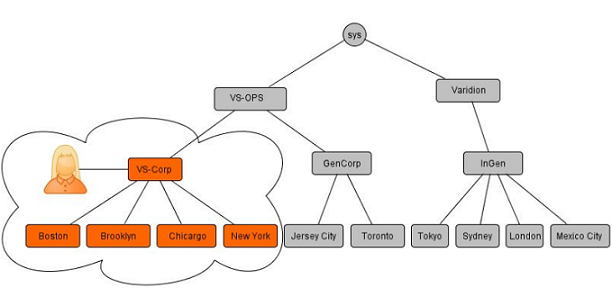Introduction to Hierarchies¶
Configurable hierarchy nodes in VOSS Automate allow the partitioning of data in a multi-tenant system.
VOSS Automate allows you to model the hierarchical nature of various types of businesses via hierarchy nodes, hierarchy node types, and hierarchy rules.
Hierarchy rules can be applied to various models in the system. An example of a hierarchy rule is that sites can only be created under a customer.
Hierarchy nodes and node types may include:
provider
reseller
customers
shared buildings
sites
divisions
branches
The hierarchy structure allows you to manage the allocation of infrastructure (such as network device lists), users, and other entities.
The diagram illustrates an example of a system that hosts two managed service providers: Varidion and VS-OPS.
VS-OPS hosts two customers: VS-Corp and GenCorp
VS-CORP operates from these locations: Boston, Brooklyn, Chicago and New York.

The ability to create administrators with different roles for different types of hierarchy nodes allows devolved administration. For example:
An administrator is responsible for the setup of the overall system.
Provider administrators own and manage infrastructure and define services available to resellers.
Resellers offer the infrastructure and services to customers or enterprises.
Customers and enterprises are grouped into various groupings.
Groupings such as divisions or branches belong to customers.
Physical locations hold users and phones.
End users consume services and manage their own configurable settings.
A flexible hierarchy allows you to:
Define as many levels as you need
Create hierarchy node instances of different types
Define the required business rules
Parent-Child Relationships¶
All entities in the system reside at a specific hierarchy and the data displayed is within the scope of the specified hierarchy. This means that every entity in the system - including users, device models and network components - has a parent hierarchy defined. A user is for example provisioned with a specific hierarchy node in a parent-child relationship. User names must be unique within a specific hierarchy.
Related Topics
